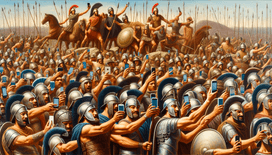Picture this: it’s the Tudor court, the air is thick with intrigue and scented with the faint whiff of desperation as courtiers vie for the affections of a famously fussy king. The man of the hour? None other than Henry VIII, a king with matrimony more notorious than matrimonial success. But what if Henry had an alchemical marvel at his disposal: Tinder? Yes, the very app designed for romance seekers and mistakers alike. How might this have transformed the tapestry of history?
Swiping Through the Ages
Imagine Henry lounging on his plush throne, jewels twinkling in the candlelight, with one eye on state matters and another on his magical glowing portrait box, a smartphone, engulfed by a universe of potential partners just a swipe away. Gone would be the days of negotiations filled with parchment rolls and messenger pigeons, replaced instead with a simple left or right, super like or strike.
This proximate Tinder universe would allow Henry to quickly traverse the vales of England and beyond. But what of the fabled six wives? Anne Boleyn springing up as an option, competing amidst a sea of “single and ready to mingle” profiles. Her bio screaming, “If you like strong wills and challenging authority, Super Like me!”
The Matrimonial Revolution
Historians often muse over Henry’s matrimonial motives. Would Tinder have simplified his amorous appetites, curbing that infamous execution vexation? Perhaps Catherine of Aragon would have been rejected based solely on her profile picture, and history would have been spared that bitter divorce that split a kingdom.
Let’s not forget Anne of Cleves, a famously mutual disappointment if ever there was one, her profile picture a painted deception. With a few taps, Henry could have followed her, subsequently regretted, and swiftly backpedalled with a deft un-match.
Profiles Deserving a Regency Scroll
Anne Boleyn’s profile would no doubt have featured her famously fiery eyes and sharp wit, perhaps including a boast of being able to juggle considerable state change whilst juggling actual jugs. Meanwhile, Jane Seymour might have gone for the down-to-earth approach, quietly hinting her desire to keep her head in the matrimonial noise.
The enigmatic Anne of Cleves might have marketed herself as the ‘girl next principality,’ boasting a photogenic smile. Clever hashtags abound: #NotanIllFatedPortrait and #ClevesTheDay.
A Court Divided by the Swipe
If Henry had access to Tinder, the impact on the court would be immeasurable. Imagine the artistic chaos: the Royal Painter now a profile consultant, the natural order knotted by every stunning swipe. Peers and peasants alike, attempting to stand out in a Tudor world where wooden swaps turn colloquial.
Courtiers would assure profilic excellence, “a picture is worth a thousand groats” becoming the well-thumbed phrase of the era. Marketing accessories, opulent frocks, and feathers would skyrocket in demand, the wealth of a nation resting on the altars of online authenticity.
Scrolling into Sovereign Satire
Tudor Tinder can’t help but leave us pondering: would this instant matchmaking service mean swift satisfaction or revolting ruination? Perhaps Henry’s affinity for flashy entrances and exits might have transitioned from the palace to the “dating world,” his iconic shame diminishing with every witty profile unmade.
Henry’s love life was historically ruled by more somber forces than playful swipes, but in this virtual veneer, smooth sigils of the digital domain could render a monarchy’s machinations marvellously mundane. After all, sometimes the dire diversions of history are one profile pic away from a different realm.
One thing’s for sure, this regal realm of Kennington kerfuffles and Greenwich giggles would make for Swipe Heaven on this alternate timeline terraforma. Henry VIII: to thine own thumb be true!







